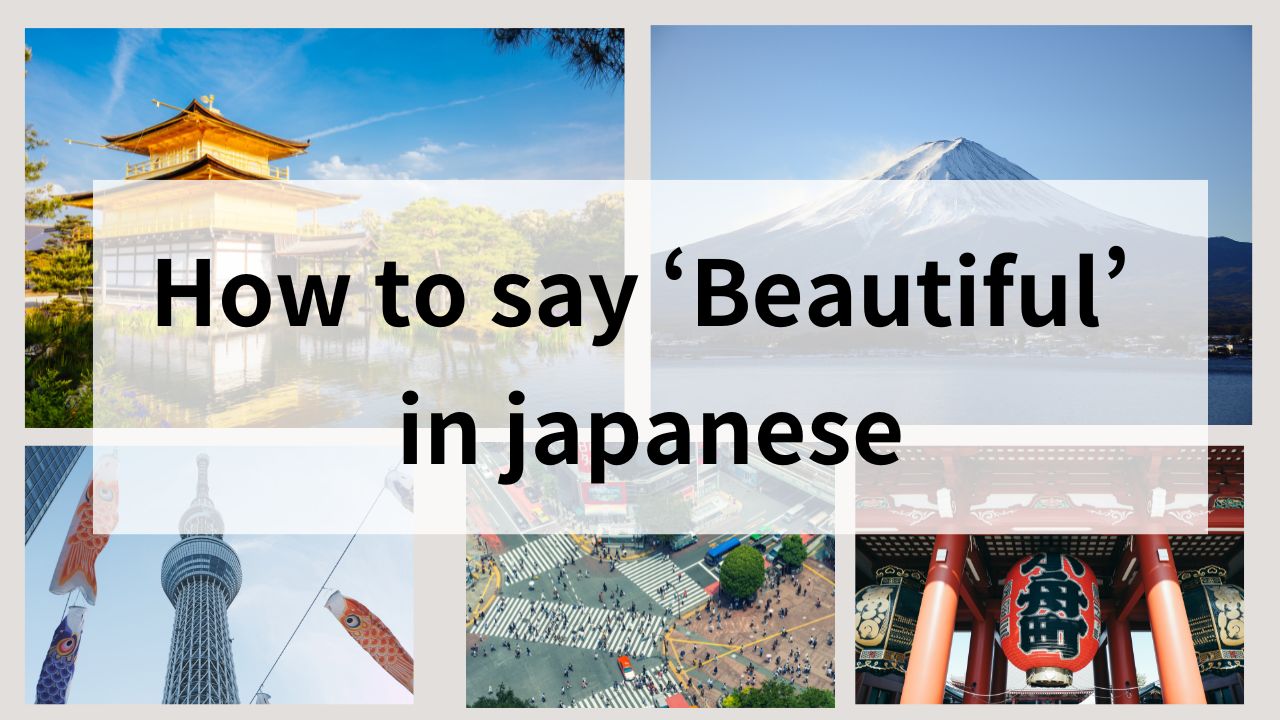Are you curious about how to say “beautiful” in Japanese? The concept of beauty is deeply rooted in Japanese culture, encompassing aesthetics, nature, and personal attributes. This guide will explore the Japanese word for “beautiful,” its cultural significance, and practical applications in everyday conversation.
How Do You Say “Beautiful” in Japanese?
The Japanese word for “beautiful” is 美しい (utsukushii). This term is widely used in both casual and formal contexts and conveys a sense of elegance and charm that resonates throughout Japanese culture.
The Japanese Word for Beautiful: Utsukushii (美しい)
“Utsukushii” is a versatile term that can describe people, nature, art, and experiences. Here are some examples of how it can be used:
- 美しい花 (Utsukushii hana): “Beautiful flower.”
- 美しい景色 (Utsukushii keshiki): “Beautiful scenery.”
- 美しい音楽 (Utsukushii ongaku): “Beautiful music.”
Kanji for Beautiful: 美
The kanji for beautiful, 美, is often used in literature, art, and everyday language. This character embodies the essence of beauty and is commonly associated with elegance and refinement. The primary reading for this kanji is び (bi), and it can also appear in compound words.
Examples of words containing the kanji 美 include:
- 美術 (Bijutsu): “Art,” referring to the creative arts where beauty is expressed.
- 美食 (Bishoku): “Gourmet food,” highlighting the aesthetic aspects of culinary arts.
- 美しい人 (Utsukushii hito): “Beautiful person,” a common compliment in Japanese culture.
This kanji is associated with various elements that reflect beauty, culture, and sophistication. Recognizing these patterns can help learners enhance their understanding of the word 美 in Japanese.
Does “Beautiful” Work in Japanese?
The English word “beautiful” is understood in Japan, especially among younger generations and those familiar with Western languages and culture. However, its recognition might be less universal among older individuals or in more traditional contexts. A 5-point scale rates its comprehension as:
- Rating: 4 – Generally understood (60-80% of people)
Rating Details
Understanding the 5-Point Rating for English Words in Japan
The following ratings help explain how English words are typically understood in Japan. The scale is based on context, familiarity, and the target audience.
- 5 – Universally understood (80% or more):
Words that are widely adopted into everyday Japanese, such as “coffee” (コーヒー) or “computer” (コンピューター). These words are part of the standard vocabulary and are recognized by nearly everyone. - 4 – Generally understood (60-80%):
Words that are familiar to most people but might require context for full comprehension. Examples include terms commonly used in specific industries or by younger generations. - 3 – Understood in half of the cases (40-60%):
Words that depend heavily on pronunciation or context. For example, technical terms or less common foreign words that some people may not immediately recognize. - 2 – May not be understood (20-40%):
Words that are unfamiliar to most Japanese speakers unless they have significant exposure to English or specific cultural contexts. These words are often better replaced with their Japanese equivalents. - 1 – Rarely understood (20% or less):
Highly specialized or obscure terms that are unlikely to be recognized by the general public. Clear communication requires the use of Japanese vocabulary or additional explanation.
This rating system provides a practical guide for determining when and how to use English words effectively in Japan. Understanding the audience and context is key to ensuring clear communication.
If clarity is crucial, using the Japanese term 美しい (Utsukushii) is recommended. While “beautiful” may be understood in certain contexts, “utsukushii” ensures effective communication.
The Cultural Significance of Beauty in Japan
Beauty has held a special place in Japanese culture for centuries, often symbolizing elegance, harmony, and spirituality. It is appreciated not only in people but also in nature, art, and everyday life.
Beauty as a Symbol of Harmony
In Japan, beauty is often associated with the concept of 和 (wa), or harmony. This principle emphasizes balance and tranquility, seen in traditional arts like tea ceremonies, flower arrangement (ikebana), and architecture.
Beauty in Japanese Folklore and Tradition
Beauty appears in various Japanese myths and stories, often symbolizing purity and grace. It is celebrated in festivals, literature, and art, enhancing its cultural significance.
In addition to its traditional associations, beauty plays a significant role in modern Japanese pop culture, particularly in fashion and media. This connection further emphasizes the value placed on aesthetics in contemporary society.
- Anime and Manga: Characters are often designed with beauty as a key trait, reflecting societal ideals and artistic standards.
- Fashion: Beauty is a central theme in Japanese fashion, with styles emphasizing elegance, creativity, and individuality.
- Traditional Arts: The beauty of calligraphy, pottery, and textiles is highly revered and forms an integral part of Japanese cultural heritage.
These examples demonstrate how beauty continues to represent harmony, purity, and cultural identity in Japan, bridging traditional values with modern expressions.
Differences Between Beauty in Japan and Overseas
Yes, there can be subtle differences in how “beautiful” is perceived in Japan versus Western cultures. In Japan, “utsukushii” (美しい) often refers to a more understated, elegant form of beauty, closely tied to nature and simplicity. In contrast, Western contexts may celebrate a broader spectrum of beauty, often emphasizing boldness and individuality. Understanding these cultural nuances can help avoid confusion, especially when discussing aesthetics in creative or professional settings.
The Difference Between “Kawaii” and “Utsukushii”
While both “kawaii” (かわいい) and “utsukushii” (美しい) are used to describe something positively in Japanese, they convey distinct nuances and are used in different contexts. Understanding their differences can help you express yourself more accurately in Japanese.
- Kawaii (かわいい):
“Kawaii” means “cute” or “adorable” and is commonly used to describe things or people that evoke a sense of charm or endearment. It is often associated with small, youthful, or playful qualities.
Example:- この猫はかわいいね! (Kono neko wa kawaii ne!): “This cat is cute!”
- かわいい服 (Kawaii fuku): “Cute clothes.”
- Utsukushii (美しい):
“Utsukushii” translates to “beautiful” and carries a more refined and elegant connotation. It is often used to describe nature, art, or people in a way that highlights their grace and sophistication.
Example:- 美しい景色 (Utsukushii keshiki): “A beautiful landscape.”
- 彼女の声は美しい (Kanojo no koe wa utsukushii): “Her voice is beautiful.”
In essence, “kawaii” leans toward “cute and charming,” while “utsukushii” emphasizes “grace and elegance.” Choosing the right word depends on the object or person you are describing and the impression you wish to convey.
Practical Applications of “Beautiful” in Japanese
Learning how “beautiful” is used in Japanese can help you navigate conversations, understand idioms, and recognize its presence in Japanese culture.
Talking About Beauty in Daily Conversation
Here are some examples of how “utsukushii” is used in everyday conversation:
- 美しいですね (Utsukushii desu ne): “It is beautiful, isn’t it?”
- 美しい景色を見ました (Utsukushii keshiki o mimashita): “I saw a beautiful scenery.”
Beauty-Related Idioms or Expressions
While there are numerous expressions that celebrate beauty, here are a few that incorporate or symbolize beauty:
- 美しさの中にある力 (Utsukushisa no naka ni aru chikara): “The power found within beauty,” a phrase emphasizing the strength and impact of beauty.
- 美は一日にして成らず (Bi wa ichinichi ni shite narazu): “Beauty is not achieved in a day,” an idiom that highlights the effort required to cultivate beauty.
- 美しい心 (Utsukushii kokoro): “Beautiful heart,” often used to describe someone with a kind and generous nature.
These idioms and expressions reflect the deep cultural and aesthetic appreciation of beauty in Japan, often tied to themes of grace, effort, and inner qualities. By learning these phrases, you can gain a deeper understanding of how beauty is interwoven with Japanese language and values.
Beauty in Japanese Cuisine or Products
Beauty is also prominently featured in Japanese cuisine and products, showcasing its aesthetic appeal and cultural significance. Here are some notable examples:
- Wagashi (和菓子): Traditional Japanese sweets that are often beautifully crafted and presented, reflecting seasonal themes and natural beauty.
- Matcha (抹茶): Green tea powder that is not only valued for its taste but also for the beauty of its vibrant color and the elegance of its preparation.
- Kintsugi (金継ぎ): The art of repairing pottery with gold, emphasizing the beauty of imperfections and the philosophy of embracing flaws.
These examples highlight how beauty transcends mere appearance, playing a significant role in Japanese culture, aesthetics, and philosophy.
FAQs
Here are some frequently asked questions about beautiful in Japanese culture and language.
Is Beautiful a Popular Concept in Japan?
Yes, beauty is a highly valued concept in Japan, often associated with art, nature, and personal attributes. It is frequently celebrated in literature, fashion, and traditional arts.
How Do You Write “Beautiful” in Japanese?
The word “beautiful” can be written in three different scripts in Japanese: hiragana, katakana, and kanji. Each script serves different purposes depending on the context and formality. Here’s a breakdown:
- Hiragana (うつくしい, Utsukushii):
Hiragana is the most commonly used script for “beautiful” in casual writing or when teaching children. It is simple and easy to read, making it ideal for everyday use. - Katakana (ウツクシイ, Utsukushii):
Katakana is rarely used for “beautiful,” but it may appear in stylistic contexts, such as advertisements, product names, or when emphasizing the word in text. - Kanji (美しい, Utsukushii):
Kanji is the most formal and traditional way to write “beautiful.” It is often used in literature, official documents, and cultural contexts. The kanji itself conveys a sense of elegance and sophistication.
Choosing which script to use depends on the tone, audience, and purpose of your communication. Understanding these variations can enhance both your written and spoken Japanese skills.
Conclusion
Beautiful, or “utsukushii” in Japanese, is more than just an adjective—it embodies cultural values, aesthetics, and deep appreciation for elegance. By understanding its role in Japanese language and traditions, you can deepen your appreciation for the concept of beauty and its significance in Japanese society.








